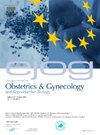Gestational weight gain and postpartum depressive symptoms in high-income women with low and late fertility
IF 1.9
4区 医学
Q2 OBSTETRICS & GYNECOLOGY
European journal of obstetrics, gynecology, and reproductive biology
Pub Date : 2025-09-30
DOI:10.1016/j.ejogrb.2025.114746
引用次数: 0
Abstract
Objective
This study aimed to investigate the relationship between GWG and postpartum depressive symptoms among high income women with ‘low and late fertility’, combined into a single category.
Methods
We examined the impact of low and late fertility on GWG, based on pre-pregnancy body mass index (BMI) categories, and postpartum depressive symptoms, tested by the Edinburgh Postnatal Depression Scale (EPDS), in a cohort of 2,561 low-risk puerperae, prior to discharge from the maternity ward of Abano Polyclinic, Abano Terme (Italy). Postpartum depressive symptoms were evaluated separately using EPDS cut-off thresholds of > 9 and > 12, as well as the Anhedonia, Anxiety, and Depression subscales.
Results
The women had a median age of 33.0 years (IQR: 30.0–37.0) and a parity of 1.00 (IQR: 1.00–2.00). A higher prevalence of pre-pregnancy underweight status (8.71 %) was observed compared to obesity (5.19 %). Additionally, 25.15 % of the participants had EPDS total scores > 9, and 10.89 % had scores > 12. Analysis revealed a significant overall association between pre-pregnancy BMI and GWG category (p < 0.001), with 47.30 % classified as having adequate GWG, 24.25 % as inadequate, and 28.43 % as excessive. Finally, GWG was not associated with an increased risk of elevated EPDS total scores (>9 or > 12) or with higher scores on the Anhedonia, Depression, or Anxiety subscales.
Conclusion
In high-income women experiencing a late first pregnancy, the lack of association between abnormal GWG and postpartum psycho-emotional distress may be influenced by a higher prevalence of pre-pregnancy underweight status over obesity.
高收入低生育和晚生育妇女的妊娠期体重增加和产后抑郁症状
目的探讨高收入“低生育和晚生育”妇女GWG与产后抑郁症状的关系,并将其合并为单一类别。方法采用爱丁堡产后抑郁量表(EPDS)对2,561名低危产妇进行了队列研究,从意大利阿巴诺特尔梅(Abano Terme)阿巴诺综合医院(Abano Polyclinic)产科病房出院前,基于孕前体重指数(BMI)类别和产后抑郁症状,研究了低生育能力和晚生育能力对GWG的影响。使用EPDS切断阈值>; 9和>; 12以及快感缺乏、焦虑和抑郁亚量表分别评估产后抑郁症状。结果中位年龄33.0岁(IQR: 30.0 ~ 37.0),胎次1.00 (IQR: 1.00 ~ 2.00)。与肥胖(5.19%)相比,孕前体重不足的患病率(8.71%)更高。此外,25.15%的参与者EPDS总分为9分,10.89%的参与者EPDS总分为12分。分析显示,孕前BMI与GWG类别之间存在显著的整体关联(p < 0.001),其中47.30%的人被归类为GWG足够,24.25%被归类为GWG不足,28.43%被归类为GWG过多。最后,GWG与EPDS总分升高(>;9或>; 12)或快感缺失、抑郁或焦虑亚量表得分升高的风险增加无关。结论高收入首次妊娠晚的女性,孕前体重过轻的发生率高于肥胖,可能导致GWG异常与产后心理情绪困扰之间缺乏相关性。
本文章由计算机程序翻译,如有差异,请以英文原文为准。
求助全文
约1分钟内获得全文
求助全文
来源期刊
CiteScore
4.60
自引率
3.80%
发文量
898
审稿时长
8.3 weeks
期刊介绍:
The European Journal of Obstetrics & Gynecology and Reproductive Biology is the leading general clinical journal covering the continent. It publishes peer reviewed original research articles, as well as a wide range of news, book reviews, biographical, historical and educational articles and a lively correspondence section. Fields covered include obstetrics, prenatal diagnosis, maternal-fetal medicine, perinatology, general gynecology, gynecologic oncology, uro-gynecology, reproductive medicine, infertility, reproductive endocrinology, sexual medicine and reproductive ethics. The European Journal of Obstetrics & Gynecology and Reproductive Biology provides a forum for scientific and clinical professional communication in obstetrics and gynecology throughout Europe and the world.

 求助内容:
求助内容: 应助结果提醒方式:
应助结果提醒方式:


